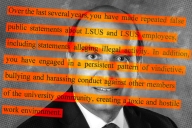You have /5 articles left.
Sign up for a free account or log in.
The American Bar Association is mulling changes -- critics say a watering down -- to its requirements on full-time faculty members at law schools. The American Association University Professors has come out against the changes, which it says will decrease the number of tenured faculty members in legal education and increase the use of adjuncts.
The rules as they currently stand require that full-time faculty members teach more than half of the total credit hours offered by a given law school in a year. Law schools can alternatively satisfy the rule by having full-time faculty teach more than two-thirds of contact hours in a year. Stemming from the ABA’s accreditation committee, the association is considering canceling those rules. (The ABA has in the past also considered policy changes opposed by faculty groups.)
While the move could be a cost-saving measure for law schools that take advantage of the new standards, the AAUP has come out against the effects of the regulation loosening, citing its potential effects on the number of full-time faculty employed at law schools.
“In many law schools, this will result in a significant increase in the percentage of part-time faculty, all or almost all of whom are in non-tenure-track positions,” the AAUP wrote in its comments to the ABA this week.
While the economic outlook for lawyers employed in adjunct positions might be rosier than those who teach composition to undergraduates, the AAUP warned of the impact decreasing the number of tenure-track positions could have on the effectiveness of law schools in their educational missions.
“This will likely be accompanied by a decrease in the percentage of full-time tenure-track appointments, and may negatively impact the diversity of the faculty and the research and teaching of innovative or controversial subjects,” its statement read.
However, Kyle McEntee, executive director and co-founder of Law School Transparency, a nonprofit group that advocates for reforming policies related to student debt, accreditation and postgraduation job prospects, said he supports the move, which he hopes will lead to lower costs for students and more flexibility for law school administrations. The current rules, he said, value professors over students.
“One of the primary issues facing legal education is the sustained lack of interest from applicants,” he said. “And a big part of that is costs, and for any school that is interested in competing on costs, this might allow them to do so more effectively.”
According to the ABA, in 2013, the average student debt from attending law school was $127,000 for those attending private institutions and $88,000 for those attending public institutions.
And with law school adjuncts, McEntee said, their situation isn’t quite like adjuncts at undergraduate institutions.
“I think one line of concern people usually have is that adjunct faculty are exploited. But that’s not exactly a problem you have in law school,” he said. “More often than not, they’re professionals giving back. And as long as they’re teaching effectively, and schools are accountable for their teaching outcomes, then schools should be able to determine what its teaching faculty looks like.”
The actual changing of the rule is still in motion. Committee meetings and hearings are taking place this weekend, and the process would take until at least February to reach a point where it could be adopted. Given that the Council of the ABA’s Section of Legal Education and Admissions to the Bar, which is responsible for the proposed rule change, is the independent arm of the ABA for accreditation purposes, and the outcome is still undecided, an ABA spokesman declined to comment.
Michael Olivas, a professor at the University of Houston Law Center, said the changes posed a risk to the mission and effectiveness of law schools. Olivas has previously served as the general counsel for AAUP and is still involved on some of its committees. He’s also previously served on the ABA council currently overseeing the potential rule change, and voted against similar proposals in the past.
“Students need to be exposed to full-time traditional faculty and full-time contingent faculty,” Olivas said, adding that he thinks there’s already enough flexibility in how law schools can count faculty. “There’s a lot more to being a faculty member [than just teaching]: being available, producing scholarship, doing the kind of necessary service to the profession and the institution. These kinds of things matter.”
Additionally, the recruiting, hiring, development and turnover of adjunct faculty often isn’t considered when looking at potential cost cuts, he said. Olivas doesn’t think Houston would take the opportunity to hire more adjuncts in lieu of full-time faculty, even if the rule is changed. He is worried, though, that lower-ranked schools might do so in an attempt to cut costs, taking “the path of least resistance.”
“These are things that don’t show up in the political economy of hiring,” he said. “When you have full-time faculty, you don’t have to keep retraining them.”
While the rule proposal comes from advocates who want to fight increasing costs at law schools, Olivas said he’s worried about the impact it could have beyond financial issues. “This would undermine the system of tenure because it would confer it on a smaller number of people,” he said. “It will weaken academic freedom.”








